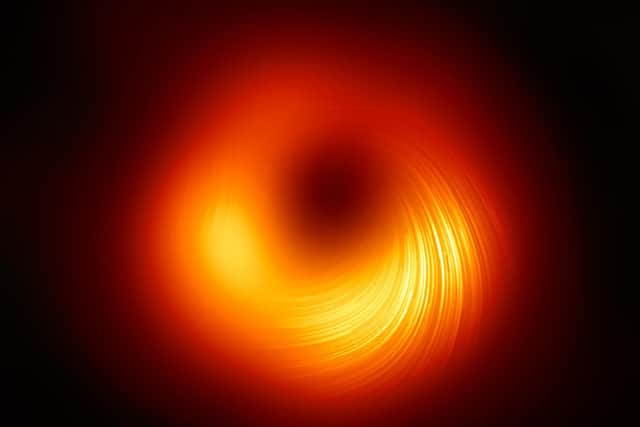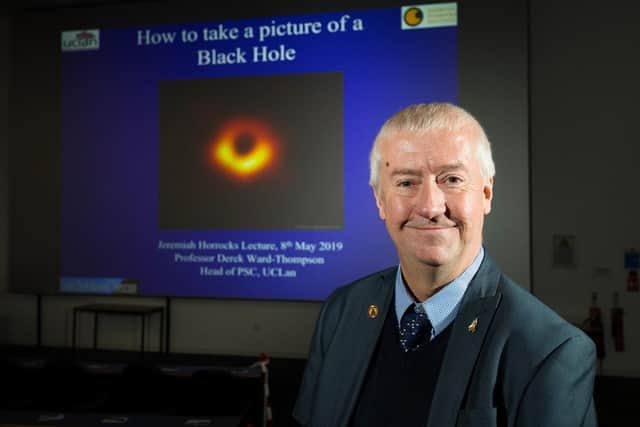How to photograph a black hole with an earth-sized telescope: Preston professor helps capture new detail
and live on Freeview channel 276
University of Central Lancashire (UCLan) professor Derek Ward-Thompson is part of the global Event Horizon Telescope (EHT) collaboration, who produced the first ever image of a black hole in 2019.
Now, a new image has captured further details of the black hole, which is at the centre of the M87 galaxy and lies 55 million lightyears from earth.
Advertisement
Hide AdAdvertisement
Hide AdIt is the first time astronomers have been able to measure polarisation, or a sign of magnetic fields, this close to the edge of a black hole.


To observe the heart of the M87 galaxy, the collaboration linked eight telescopes around the world, including the James Clerk Maxwell Telescope, which is financed by UCLan, to create a virtual earth-sized telescope (the EHT).
The resolution of the EHT is equivalent to what it would take to measure the length of a credit card on the surface of the moon and more than 300 researchers were involved worldwide.
The new observations are key to explaining how the M87 galaxy launches energetic 'jets' from its core.
Advertisement
Hide AdAdvertisement
Hide AdProfessor Ward-Thompson, who is the head of UCLan’s School of Natural Sciences, said: “This unique observation means that for the first time we can map the magnetic fields around a black hole right into the region of the event horizon.


"This is exciting because astronomers believe that the magnetic fields are responsible for launching ionised material millions of light years into space in what we call ‘jets’, which can be ten times larger than the entire galaxy.
The astrophysicist said it was 'extremely difficult' to capture this new detail.
“Not only do we have to record the intensity of the light in the manner of a camera, we also have to record its polarisation in the manner of a pair of polaroid sunglasses," the professor said.
Advertisement
Hide AdAdvertisement
Hide Ad"So, in the same way as sunglasses dim the amount of light we see from the sun, the polariser on our telescope dims the amount of light we can see from the black hole, making it much more difficult to detect.”
It was not possible to capture this detail in 2019 but the new findings help to develop physicists' understanding.
Iván Martí-Vidal, a coordinator of the EHT Working Group, said: “Unveiling this new polarised-light image required years of work due to the complex techniques involved in obtaining and analysing the data.”
This follows the release of the first ever image of a black hole on April 10 2019.
Advertisement
Hide AdAdvertisement
Hide AdThe now familiar photograph shows a bright ring-like structure with a dark central region — the black hole’s shadow.
Since then, the EHT collaboration has delved deeper into the data on the supermassive object and discovered that a significant fraction of the light around the black hole is polarised.
EHT member Andrew Chael, from the USA, said: “The newly published polarised images are key to understanding how the magnetic field allows the black hole to 'eat' matter and launch powerful jets.”
Light becomes polarised when it goes through certain filters, like the lenses of polarised sunglasses, or when it is emitted in hot regions of space.
Advertisement
Hide AdAdvertisement
Hide AdIn the same way that polarised sunglasses help us to see better by reducing reflections and glare from bright surfaces, astronomers can sharpen their vision of the region around the black hole by looking at how the light is polarised.
Polarisation allows astronomers to map magnetic field lines at the inner edge of the black hole.
Most matter lying close to the edge of a black hole falls in.
However, some of the surrounding particles escape moments before capture and are blown far out into space in the form of jets.
Advertisement
Hide AdAdvertisement
Hide AdAstronomers have relied on different models of how matter behaves near the black hole to better understand this process.
It is still not known exactly how jets larger than the galaxy are launched from its central region,or how exactly matter falls into the black hole.